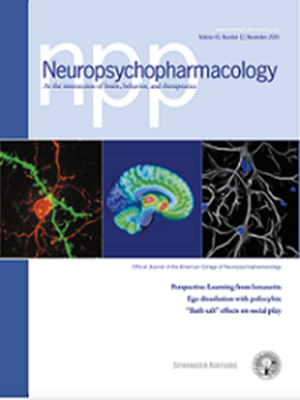The role of sex in the association between cannabis use disorder and resting-state functional connectivity
IF 6.6
1区 医学
Q1 NEUROSCIENCES
引用次数: 0
Abstract
While Cannabis use disorder (CUD) is twice as prevalent in males, females transition more quickly from heavy use to CUD and experience more severe withdrawal. These clinically relevant sex differences contrast the lack of knowledge about the underlying brain mechanisms. This study investigated the relationship between CUD and resting-state functional brain connectivity (RSFC), assessing potential sex differences herein. RSFC of the Salience Network (SN), Basal Ganglia Network (BGN), Executive Control Network (ECN), and Default Mode Network (DMN) was compared between 152 individuals (76 males) with CUD and 114 matched controls (47 males). Within the CUD group, relationships between RSFC and heaviness of cannabis use, age of onset, and CUD symptom severity, along with their associations with sex, were investigated. CUD and control groups showed similar RSFC across all networks, regardless of sex. In the CUD group, heavier cannabis use correlated with higher RSFC across all networks and earlier age of onset was related to higher RSFC in the anterior SN, BGN, left ECN, and dorsal DMN. These associations were similar for males and females. CUD severity was related to higher RSFC in the anterior SN, which was moderated by sex, with a positive association seen only in males. In conclusion, CUD may not necessarily be associated with altered RSFC. Individual use characteristics such age of onset and severity of use may determine the potential impact of cannabis use on RSFC in a largely similar way in males and females.

性在大麻使用障碍和静息状态功能连接之间的关联中的作用。
虽然大麻使用障碍(CUD)在男性中的发病率是男性的两倍,但女性从大量使用大麻过渡到CUD的速度更快,戒断症状也更严重。这些临床相关的性别差异与缺乏对潜在大脑机制的了解形成了对比。本研究探讨了CUD与静息状态功能脑连接(RSFC)之间的关系,评估了其中潜在的性别差异。比较了152例CUD患者(76例男性)和114例匹配对照(47例男性)的显著性网络(SN)、基底神经节网络(BGN)、执行控制网络(ECN)和默认模式网络(DMN)的RSFC。在CUD组中,研究了RSFC与大麻使用量、发病年龄和CUD症状严重程度之间的关系,以及它们与性别的关系。CUD组和对照组在所有网络中都显示出相似的RSFC,不分性别。在CUD组中,更重的大麻使用与所有网络中较高的RSFC相关,更早的发病年龄与SN前部、BGN、左侧ECN和DMN背部较高的RSFC相关。这些关联在男性和女性中是相似的。CUD严重程度与SN前部较高的RSFC相关,且受性别影响,仅在男性中可见正相关。总之,CUD可能不一定与RSFC改变有关。个体使用特征,如发病年龄和使用严重程度,可能以大致相似的方式决定大麻使用对男性和女性RSFC的潜在影响。
本文章由计算机程序翻译,如有差异,请以英文原文为准。
求助全文
约1分钟内获得全文
求助全文
来源期刊

Neuropsychopharmacology
医学-精神病学
CiteScore
15.00
自引率
2.60%
发文量
240
审稿时长
2 months
期刊介绍:
Neuropsychopharmacology is a reputable international scientific journal that serves as the official publication of the American College of Neuropsychopharmacology (ACNP). The journal's primary focus is on research that enhances our knowledge of the brain and behavior, with a particular emphasis on the molecular, cellular, physiological, and psychological aspects of substances that affect the central nervous system (CNS). It also aims to identify new molecular targets for the development of future drugs.
The journal prioritizes original research reports, but it also welcomes mini-reviews and perspectives, which are often solicited by the editorial office. These types of articles provide valuable insights and syntheses of current research trends and future directions in the field of neuroscience and pharmacology.
 求助内容:
求助内容: 应助结果提醒方式:
应助结果提醒方式:


